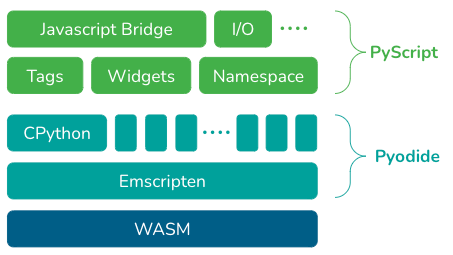PyConUS2022 announced PyScript to execute Python code in the browser, relying on pyodide (CPython for WebAssembly). It is much closer to the web development experience than pyodide. The published alpha version output Python version information is: 3.10.2 (main, Apr 9 2022, 20:52:01) [Clang 14.0.0 (https://github.com/llvm/llvm-project 78e87970af888bbbd5652c31f3a8

Install
Just add HTML tags to load the files:
But it will request pyodide.asm related files from cdn.jsdelivr.net. The entire dependency has 22MB, requiring a good network setup first.
Usage
Embed Python code in HTML using the <py-script> tag. Take two scenarios very commonly used in web development: fetch data from api and query data from database.
Fetch data
This version of pyscript cannot yet initiate web requests directly with the Python library, and calls to http.client will report the following error:
File "/lib/python3.10/http/client.py", line 941, in connect
self.sock = self._create_connection(
File "/lib/python3.10/socket.py", line 845, in create_connection
raise err
File "/lib/python3.10/socket.py", line 833, in create_connection
sock.connect(sa)
BlockingIOError: [Errno 26] Operation in progress
Even call asyncio to do the processing, the browser initiates the WebSocket connection by default. Call pyodide.http.open_url to get the data or use Javascript’s fetch to get the data from the interface and display it on the page with the following code.
| Key | Value |
|---|
Accessing the database
List of Python packages supported by pyodide: https://github.com/pyodide/pyodide/tree/main/packages
Sqlalchemy, the main ORM package, is already supported. But can’t connect to remote databases yet because of missing dependencies and browser limitations, use Sqlite’s inmemory mode with the following code.
- sqlalchemy # 其他包使用 引入
from sqlalchemy import create_engine, text
engine = create_engine("sqlite+pysqlite:///:memory:", future=True) # Sqlite Connection
with engine.connect() as conn:
conn.execute(text("CREATE TABLE sites (name string, domain string)")) # Create table, insert data and commit
conn.execute(
text("INSERT INTO sites (name, domain) VALUES (:name, :domain)"),
[{"name": "Dmyz1", "domain": "http://dmyz.org"}, {"name": "Dmyz2", "domain": "http://dmyz.net"}],
)
conn.commit()
result = conn.execute(text("SELECT * FROM sites"))
for row in result.all(): # Iterate results and directly print
print("Site: {}, Domain: {}".format(row[0], row[1]))
REPL
Afterwords
WebAssembly has been developed for nearly a decade, and “let the browser run C/C++ code” sounds as novel as nodejs, but there are only some simple demos. When I came across iodide and pyodide a few years ago, I only thought they were similar to Jupyterhub, but I didn’t think they were suitable for that purpose.
PyScript seemed to be just pyodide with a few HTML tags, but it was much smoother to use. My first impression was that it was a hybrid of PHP/JSP, and then I realized that it advanced the goal of WebAssembly: to make C(Python)/C++ a real language that can be directly parsed by browsers and is easy to use. Although limited by Internet speed, browser performance and other factors, can not replace Javascript, but for some specific areas, especially Python is good at data processing / machine learning, PyScript should be able to take away some from Javascript. And Python engineers, the future is a veritable Web full-stack.